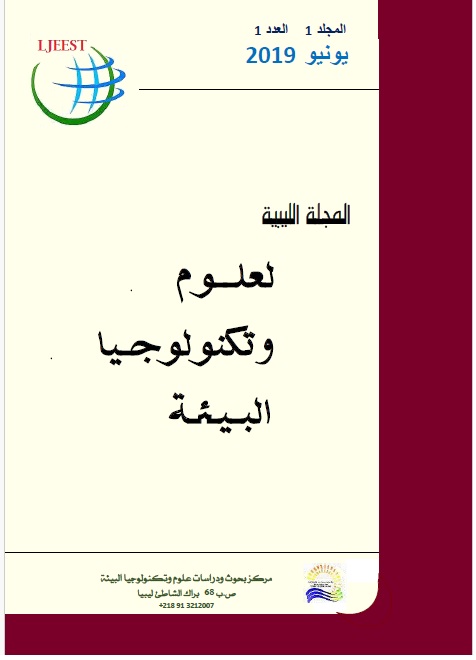تأثير مستخلص ماء شجرة البلوط (Pistacia lentiscus L.) على مراحل النمو المبكرة للخردل والحلفة
DOI:
https://doi.org/10.63359/bj7n9q54الكلمات المفتاحية:
الأللوباثي، المستخلص المائي، نسبة الإنبات، المصطكي (Pistacia lentiscus L.)، الفجل الأبيض (Raphanus sativus L.)الملخص
تم تقييم آثار المستخلصات المائية للأجزاء الهوائية من شجيرة المصطكي (Pistacia lentiscus L.) بتركيزات مختلفة (20 ، 40 ، 80٪) على إنبات ونمو الشتلات لـنبات الفجل Raphanus sativus L. ونبات الحلبة graecum- Trigonella foenum بعد 7 أيام "في المختبر". كان لنبات البطم Pistacia آثار اليلوباثية قوية ، فقد قلل من نمو وإنبات شتلات الفجل والحلبة ، في جميع التركيزات المختبرة. وأظهرت النتائج التي تم الحصول عليها تثبيط كبير في نسبة الإنبات (GP) ، وطول الرويشة (PL) وطول الجذير((RL فى كل من بذور الفجل والحلبة ، وكانت درجة التثبيط تعتمد على التركيز, حيث وجد انه عند التراكيز 20،40 و 80٪ من المستخلصات المائية لنبات البطم ، تم تقليل نسبة إنبات بذور الفجل إلى (81.67 ، 71.67 و 55٪) على التوالي ، في حين تم تقليل إنبات بذور الحلبة إلى (75 ، 56.67 و 45٪) على التوالي ، مقارنة مع السيطرة التي كانت 100 ٪ و 98.3 ٪ للفجل و الحلبة على التوالي.
المراجع
Al-Charchafchi, F. M. R., Redha, F. M. J., & Kamal, W. M. (1987). Dormancy of Artemisia herba alba seeds in relation to endogenous chemical constituents. Journal Biological Science Research ., Baghdad/Iraq, 11, 1-12.
Al‐Habbal, M. J., Al‐Habbal, Z., & Huwez, F. U. (1984). A double‐blind controlled clinical trial of mastic and placebo in the treatment of duodenal ulcer. Clinical and experimental pharmacology and physiology, 11(5), 541-544.
Alma, M. H., Nitz, S., Kollmannsberger, H., Digrak, M., Efe, F. T., & Yilmaz, N. (2004). Chemical composition and antimicrobial activity of the essential oils from the gum of Turkish pistachio (Pistacia vera L.). Journal of agricultural and food chemistry, 52(12), 3911-3914.
Amri, I., Gargouri, S., Hamrouni, L., Hanana, M., Fezzani, T., & Jamoussi, B. (2012). Chemical composition, phytotoxic and antifungal activities of Pinus pinea essential oil. Journal of Pest science, 85(2), 199-207.
Bajalan, I., Zand, M., & Rezaee, S. (2013). Allelopathic effects of aqueous extract from Salvia officinalis L. on seed germination of barley and purslane. International Journal of Agriculture and Crop Sciences, 5(7), 802.
Balasundram, N., Sundram, K., & Samman, S. (2006). Phenolic compounds in plants and agri-industrial by-products: Antioxidant activity, occurrence, and potential uses. Food chemistry, 99(1), 191-203.
Batish, D. R., Kaur, M., Singh, H. P., & Kohli, R. K. (2007). Phytotoxicity of a medicinal plant, Anisomeles indica, against Phalaris minor and its potential use as natural herbicide in wheat fields. Crop Protection, 26(7), 948-952.
Batish, D. R., Singh, H. P., Kaur, M., Kohli, R. K., & Yadav, S. S. (2008). Caffeine affects adventitious rooting and causes biochemical changes in the hypocotyl cuttings of mung bean (Phaseolus aureus Roxb.). Acta physiologiae plantarum, 30(3), 401-405.
Benhammou, N., Bekkara, F. A., & Panovska, T. K. (2008). Antioxidant and antimicrobial activities of the Pistacia lentiscus and Pistacia atlantica extracts. African Journal of Pharmacy and Pharmacology, 2(2), 022-028.
Bozorgi, M., Memariani, Z., Mobli, M., Salehi Surmaghi, M. H., Shams-Ardekani, M. R., & Rahimi, R. (2013). Five Pistacia species (P. vera, P. atlantica, P. terebinthus, P. khinjuk, and P. lentiscus): a review of their traditional uses, phytochemistry, and pharmacology. The Scientific World Journal.
Callaway, R. M., & Vivanco, J. M. (2006). Can plant biochemistry contribute to understanding of invasion ecology?. Trends in Plant Science, 11(12), 574-580.
El-Gali, Z. I. (2016). First record of Pestalotiopsis spp. from affected leaves of mastic shrubs (Pestacia lentiscus L.) in northeastern of Libya. International Journal of Bioassays, 5(8), 4744-4749.
Elshatshat, S. A. (2010). Allelopathic Effects of Artemisia Herba-Alba Aqueous Extracts on Germination of Tomato and Wheat Seeds. Journal of Science and Its Applications, 4(1), 1-6.
Escudero, A., Albert, M. J., Pita, J. M., & Pérez-García, F. (2000). Inhibitory effects of Artemisia herba-alba on the germination of the gypsophyte Helianthemum squamatum. Plant Ecology, 148(1), 71-80.
Fateh, E., Sohrabi, S. S., & Gerami, F. (2012). Evaluation the allelopathic effect of bindweed (Convolvulus arvensis L.) on germination and seedling growth of millet and basil. Advances in Environmental Biology, 6(3), 940-950.
Habib, S. A., & Rahman, A. A. (1988). Evaluation of some weed extracts against field dodder on alfalfa (Medicago sativa). Journal of chemical ecology, 14(2), 443-452.
Huda, E., Laila, A., Amina, Z., & Fathia, E. (2017). Pistacia lentiscus tree and its role in riddance of some environmental polluters. EC Nutrition, 10 (1) : 8-14.
Hussain, F., & Khan, T. W. (1988). Allelopathic effects of Pakistani weed Cynodon dactylon (L.) pers [on wheat, barley and maize]. Pakistan Journal of Weed Science Research (Pakistan).
Hussain, F., Ahmad, B. A. S. H. I. R., & Ilahi, I. H. S. A. N. (2010). Allelopathic effects of Cenchrus ciliaris L. and Bothriochloa pertusa (L.) A. Camus. Pakistan Journal of Botany, 42(5), 3587-3604.
Hussain, M. I., & Reigosa, M. J. (2011). Allelochemical stress inhibits growth, leaf water relations, PSII photochemistry, non-photochemical fluorescence quenching, and heat energy dissipation in three C3 perennial species. Journal of Experimental Botany, 62(13), 4533-4545.
Hussain, M. I., & Reigosa, M. J. (2014). Evaluation of herbicide potential of sesquiterpene lactone and flavonoid: impact on germination, seedling growth indices and root length in Arabidopsis thaliana. Pakistan Journal of Botany, 46(3), 995-1000.
Iauk, L., Ragusa, S., Rapisarda, A., Franco, S., & Nicolosi, V. M. (1996). In vitro antimicrobial activity of Pistacia lentiscus L. extracts: preliminary report. Journal of chemotherapy, 8(3), 207-209.
Jafri, S.M.H., & El-Gadi, A. (1983) flora of Libya ,vol., 107. (Asteraceae). Department of Botany, Al-Fateh University Tripoli, Libya.
Keating, K. I. (1999). Allelopathy: principles, procedures, processes, and promises for biological control. In Advances in agronomy (Vol. 67, pp. 141-231). Academic Press.
Nesrine, S., El-Darier, S. M., & EL-Taher, H. M. (2011). Allelopathic effect of some medicinal plants on germination of two dominant weeds in Algeria. Advances in Environmental Biology, 5(2), 443-446.
Periotto, F., Perez, S. C. J. G. D., & Lima, M. I. S. (2004). Allelopathic effect of Andira humilis Mart. ex Benth in the germination and growth of Lactuca sativa L. and Raphanus sativus L. Acta botânica brasílica, 18(3), 425-430.
Reigosa, M. J., Pedrol, N., & González, L. (Eds.). (2006). Allelopathy: a physiological process with ecological implications. Springer Science & Business Media. . pp:639.
Rizvi, S. J. H., Tahir, M., Rizvi, V., Kohli, R. K., & Ansari, A. (1999). Allelopathic interactions in agroforestry systems. Critical Reviews in Plant Sciences, 18(6), 773-796.
Ross, S. M. (2004). Introduction to probability and statistics for engineers and scientists. 3rd ed. USA .Elsevier.
Scott, S. J., Jones, R. A., & Williams, W. (1984). Review of Data Analysis Methods for Seed Germination 1. Crop science, 24(6), 1192-1199.
Scrivanti, L. R., Zunino, M. P., & Zygadlo, J. A. (2003). Tagetes minuta and Schinus areira essential oils as allelopathic agents. Biochemical systematics and ecology, 31(6), 563-572.
Weir, T. L., Park, S. W., & Vivanco, J. M. (2004). Biochemical and physiological mechanisms mediated by allelochemicals. Current opinion in plant biology, 7(4), 472-479.
Williams, R. D., & Hoagland, R. E. (1982). The effects of naturally occurring phenolic compounds on seed germination. Weed science, 30(2), 206-212.
Wilson, J. B., & Agnew, A. D. (1992). Positive-feedback switches in plant communities. In Advances in ecological research (Vol. 23, pp. 263-336). Academic Press.
Xu, Z., Guo, D., Yu, L., Zhao, M., Zhang, X., Li, D., & Ye, Y. (2003). Molecular biological study on the action mechanism of rice allelochemicals against weeds. The journal of applied ecology, 14(5), P-829.
Zahed, N., Hosni, K., Brahim, N. B., Kallel, M., & Sebei, H. (2010). Allelopathic effect of Schinus molle essential oils on wheat germination. Acta physiologiae plantarum, 32(6), 1221-1227.












